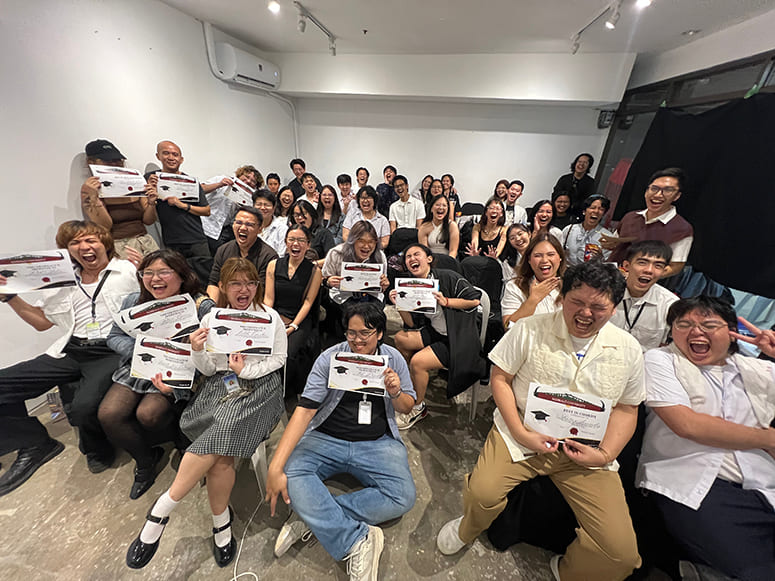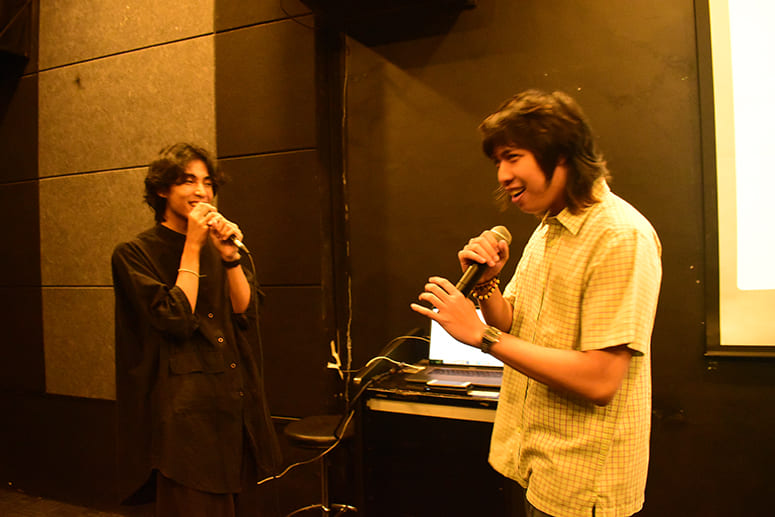Cinema of alternative noise
Armed with a Facebook “sh*tposting” group, a penchant for movies and memes, and a dream, Kinoise PH organically evolved into a close-knit film collective driven by its shared “passion for the niche and underground.”
Now, a bit of Kinoise lore. “Kinoise,” a portmanteau of “kino” (meaning “cinema” in European languages) and “noise,” is an iteration of the Facebook group’s original name, “Keenoise,” itself a variant of the local music Facebook group named “Peenoise,” a silly autological word coined from “Pinoys” and “noise.”
Though Kinoise Filmposting Philippines, the local film Facebook group with over 1,600 members, had already been up years prior, it was only in 2023 that it became a serious deal. It began at a screening and forum on Super 8mm cinema at the Ateneo Art Gallery, featuring the likes of Nick Deocampo, Raymond Red, Erwin Romulo, Jun Sabayton, Jesed Moreno, and Roxlee.
Kinoise core Red Sales, Jetri Bolintiam, Mac John Bautista, and Kalila Camilon were all there. Inspired by the event’s insights on Philippine alternative cinema, they thought of kickstarting a similar initiative through Kinoise PH, as the group was growing its reach.
“During the pandemic, in the lead up to that point in 2023, we had a ton of Discord screenings,” says Bolintiam, a filmmaker and programmer, over Zoom. “So it was kind of the online community that we formed over the pandemic that kind of activated (the idea) in our brains that film things are happening again, (so why not) jump right on it.”
Thus began the commitment, alongside other core members: Hiraya Buan, Jaden Tomacruz, FJ Calvario, Karl Maalab Paredes, Renée Frizca, Javi Villaluz, Riann Limcangco, and Ligaya Lugosi. The collective tried its hand at making original films, covering various film efforts, and creating discourse around alternative and independent cinema. “That evolved from early 2024 into more of the screening and curation type that we heavily do (now),” Bolintiam continues.
Kinoise’s focus on alternative cinema mirrors the spirit of the collective: independent, do-it-yourself, ragtag. “So, if we were to screen films, these films were gonna be from people we would actually be able to talk to. These would be like independent artists, students, and outsiders in the industry,” says Sales, who also hopped on the Zoom call. “We all wanted to work together in that way because they’re the ones who need more coverage, and at the same time, they had no way of getting it without any support from the industry.”
The kind of moving images that the group curates and screens also serve as inspirations for its “very DIY form of film production.” “And when we talk about what we post or the kind of discourse that we want to uplift, these are also the films that are most worth talking about,” adds Sales, a Las Piñas-based writer and filmmaker, who’s also a QCinema Critics Lab alum. “Not just because no one was talking about them (and) they deserved to be talked about, but the discourse that they inspired was truly unique and refreshing, from all these different voices and different perspectives. There’s just so (many) ways of reading them. A lot of people had new things to say. And that’s the kind of area we wanted to shine a light on.”
Sales and Bolintiam, who both volunteer for independent news outlet Mayday Multimedia, are hyper-aware that the lack of access to alternative and experimental works results in little to no appreciation for the craft and in a kind of aversion to anything unpolished, low-res, and substandard. Accessibility, explains Bolintiam, is two-pronged. “It’s easy for us to get it and it’s easy for us to reach out to the filmmakers, but at the same time, these are still obscure films, so we want these independent and experimental works to be accessible outside of just our circles.”

Kinoise is also propelled by its “anti-hegemonic” philosophy. “The mainstream industry is such a behemoth and profit-driven,” says Bolintiam, who just completed his economics degree at the University of the Philippines Diliman this year. “There’s like a sense of anti-independent there that we kind of want to fight back against by really being champions of the alternative.”
The film curator, who’s now participating in the first edition of Teka-teki Sinema Film Programming Workshop in Indonesia, says that alternative cinema is not just alternative in its mode of production but also in its content and politics. “That just comes with the package of being made outside of the studio system, outside of the industry,” he tells me.
This same thinking hacks into the way Kinoise mounts its screenings and initiatives, which are often free of charge and held in outdoor, grassroots spaces. Cinema, through the lens of Kinoise, is a communal experience, an onscreen life whose meaning and value move past celluloid immortality, a life sustained by even the most modest, makeshift efforts.
One such effort was the Sinepasada film festival that the collective organized in April 2024, at the peak of the transport strikes against the Marcos government’s jeepney modernization program, which labor groups described as “anti-poor” and “unjust.” Initially a collaboration with Tanggol Pasada Network that later included other advocacy groups such as SIKAD and Rural Women Advocates (RUWA), Sinepasada doubled as a screening and fundraising effort to support jeepney drivers who, at the time, were protesting the national push to phase out traditional jeepneys without adequate support for the affected sector.
The community screening featured titles such as Gabo Pancho’s Tatay Elmer, James Magnaye’s Baon sa Biyahe, and Jayson Santos’ Para sa Pasada, which all train its camera on the laboring lives steering the country’s cultural staple and main mode of public transportation, alongside National Artist Kidlat Tahimik’s 1977 masterpiece Mababangong Bangungot (Perfumed Nightmare) and Yugantar’s 1982 proletariat gem Tobacco Embers.
The festival banked on a twofold approach. “We have educational discussions, we have the voices of the masses directly to raise awareness, make sure that the advocacy reaches people who want to organize, and to directly help the cause by earning money,” Bolintiam says. Though Kinoise initially ran Sinepasada at a loss, it eventually raised around P15,000 for the transport network Pagkakaisa ng mga Samahan ng Tsuper at Operator Nationwide (PISTON).
Bolintiam, a commuter himself, also documented his personal encounters with the country’s transport crisis in the eight-minute experimental documentary Concrete Conflicts, co-directed with Paredes and Bryle Mikkoel Ilagan, which situates the viewer right into the nexus of the labor movement, motored by its raw and frenetically textured visual lexicon.
Another initiative that’s particularly significant to Kinoise was the Ing Sulu Ning Eskwela impact screening and filmmaking workshop for the Aeta students of Sitio Haduan in Mabalacat, Pampanga. Held for free in August 2024, the project screened the likes of EJ Gagui’s Lugal Abu, Zig Dulay’s Black Rainbow, and Project Kaluguran’s Aduan Nang Monica, followed by conversations about social justice and indigenous people’s rights.
The mainstream industry is such a behemoth and profit-driven. There’s like a sense of anti-independent there that we kind of want to fight back against by really being champions of the alternative.
“Super DIY, but we were talking to them directly, interacting with them, seeing them watch the films,” recalls Sales. “All of us in the group agreed that it’s like the most fulfilling thing we’ve ever done because you can kind of see the impact or the influence on their faces. They were so happy, and it kind of felt (like) that kind of thing doesn’t happen often for them.”
That kind of project, notes Sales, is what Kinoise hopes to replicate in the future, despite the organization’s shoestring budget. “I think we all have these beliefs already,” he surmises. “And I think we’re all people (who) care. We just happen to all be into film as well. So I think all of us just believe that we have to use any of our skills, resources, (and) connections to just do good. Just to make the world a better place. Because that makes better films, better film communities in general.”
“It’s bigger than movies at the end of the day,” Sales finishes.
Kinoise does everything by themselves, from film programming to logistics (“venue hell” is their term for instances when they can’t find a place to screen) and doorkeeping. Sales, though, reiterates that, in the collective, no labor is rendered invisible. “When we produce films, there has to be no exploitation happening at all,” he says. “If we have accidentally exploited anyone at any of our projects, we’d rather just not do the project. That’s one of our main advocacies.”
These efforts that marry alternative cinema and social advocacy also function as a way for Bolintiam to make sense of film curation’s role as a “radical act.” “It just goes to show how being in touch with a community and the people around you really goes a long way for your own taste and for building that empathy towards everyone else,” says Bolintiam, who will continue to broaden his knowledge as a programmer for the Malaysian-based SeaShorts Film Festival in October.
“Simply bringing together people is one of the most important things politically because, as (film critic and educator) Epoy Deyto said, ‘you can’t politicize people that you don’t meet,’” he continues. “Curation has been our way of tapping into the community, tapping into people whose political ideals need some steps to become class conscious and really see what their impact can be in a community.”
“I, as the curator, effectively know nothing,” Bolintiam declares. “Everything I learn is from the audience.”

Asked about the place of local alternative and independent cinema in the broader cultural consciousness, Sales says it will always remain niche. “I mean, it’s unfortunate, but cultural consciousness follows whoever can pay for it, whoever has the marketing or the machinery for it,” he explains. “And by definition, that’s not gonna be alternative and independent cinema.”
Sales asserts alternative cinema, in the current context, “feels more alive than ever.” He argues that “the beauty of these films (is) inseparable from their modes of production,” pointing out that it’s a kind of cinema that’s always aligned and defined itself with cheaper technology, the likes of Super 8mm camera and the digital method of the aughts. “And right now, there’s been a boom of more methods of distribution and production that are much more attainable at an independent level.”
“The reason why we like these films is because these are alternative voices,” Sales adds, “from people who made films without budgets, who have messages that are not marketable, who will not get supported by any studio or any PR team, but that’s what makes them good.”
Like the films it screens, Kinoise proposes a counterpoint to the sweeping notion that often locates cinema in Herculean terms: DIY, grounded, incremental, and engined by community. In many ways, the collective shows us not just the possibilities of cinema but also the labor that keeps it running, and the small, ordinary lives that it constantly fixates its gaze on. Now, the commitment continues: meeting new people, creating more discourse through films and printed matter, and connecting with communities. Here is cinema that makes useful, alternative noise. If this is what sh*tposting can do, then hell yes.


